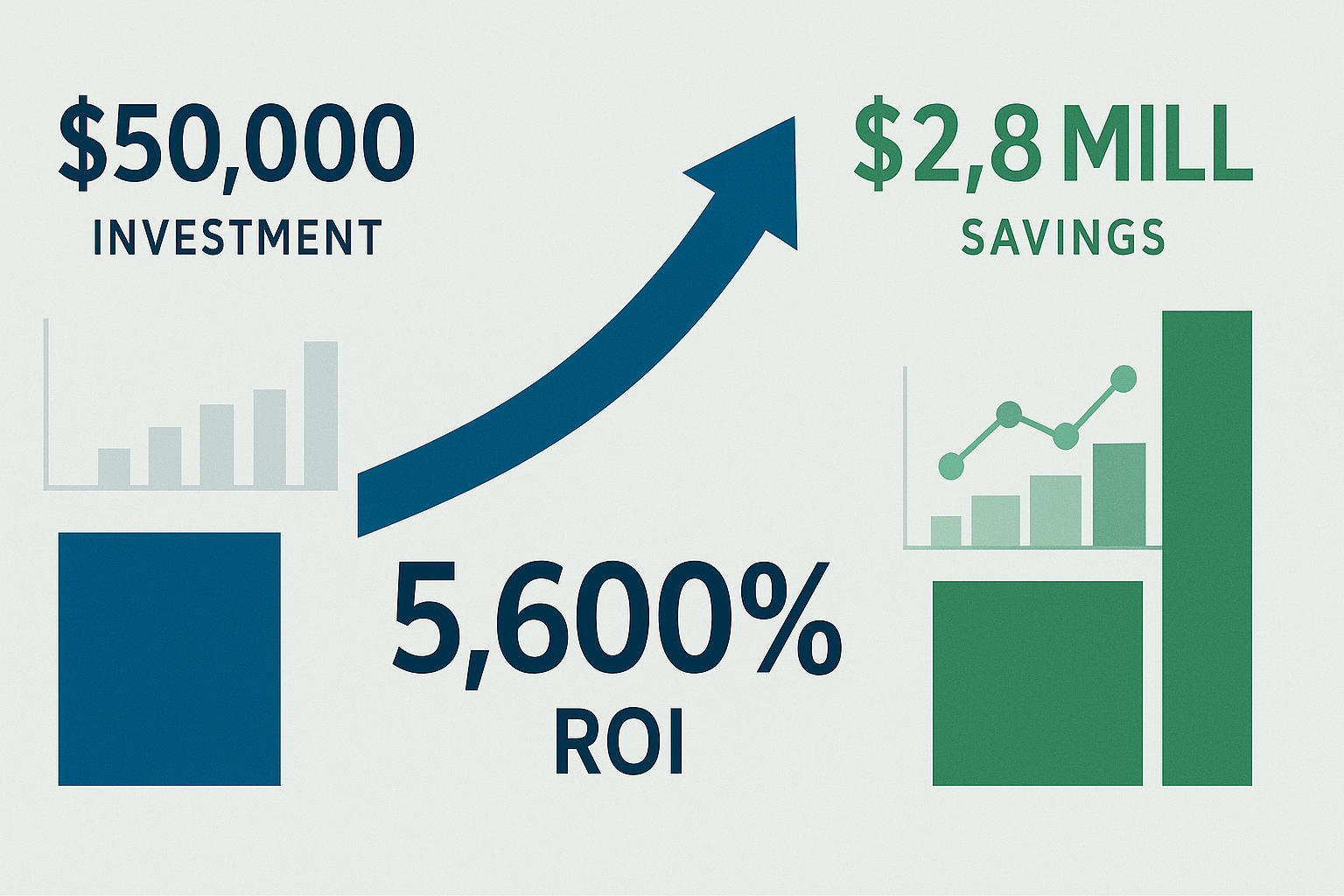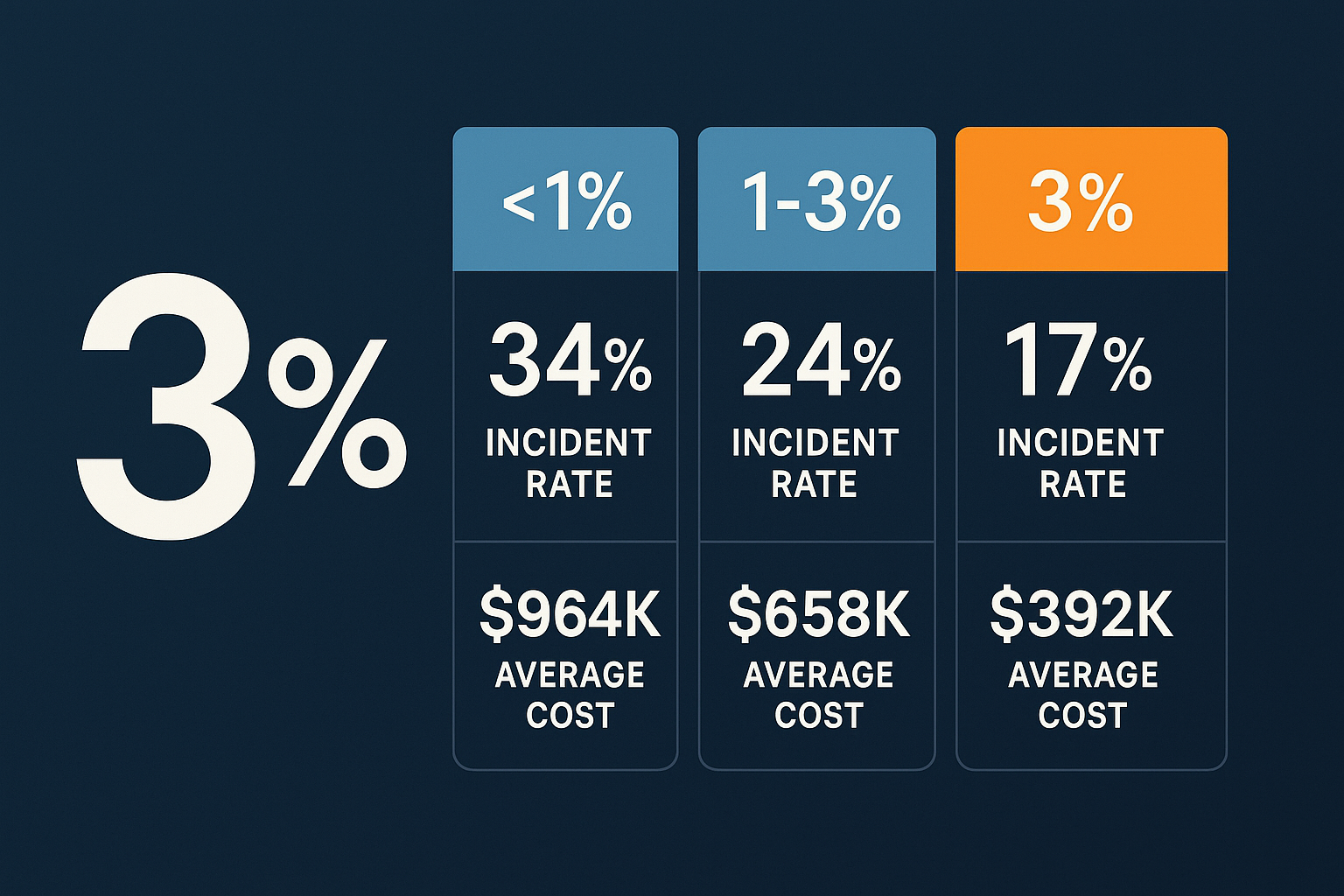 View all blogs
View all blogs
The $50,000 Security Budget That Saved $2.8 Million (Real Numbers)

“We Can’t Afford Cybersecurity”
That’s what the CEO told me in January during our first meeting. By March, he was writing a check for emergency incident response. By June, he’d tripled his security budget.
What changed? A near-catastrophic attack that almost destroyed his $12 million manufacturing business—and the realization that his “we can’t afford security” mindset nearly cost him everything.
This is the story of how a $50,000 cybersecurity investment prevented $2.8 million in losses, told with real numbers and actual outcomes.
The Initial Resistance
“Look, Erik,” the CEO said, “we’re a small manufacturing company. We make industrial components, not software. Who’s going to attack us?”
His current “cybersecurity strategy”:
- Basic antivirus on some computers
- Password policy (when he remembered to enforce it)
- Backup to an external drive (last backup: 6 months ago)
- Total annual security spending: $3,200
Sound familiar? This mindset is shared by 67% of small and medium businesses according to Cybersecurity Ventures research. They see cybersecurity as an IT expense, not a business necessity.
The Wake-Up Call
On March 15th at 3:47 AM, everything changed.
A sophisticated spear-phishing email landed in the controller’s inbox. It appeared to come from their largest customer, requesting an urgent invoice update. The controller, working late to meet month-end deadlines, clicked the link.
Within minutes:
- Ransomware began encrypting every file on the network
- Production systems went offline
- Customer database became inaccessible
- Financial records were locked
- Email system crashed
By morning, 85% of their digital infrastructure was encrypted with a ransom demand for $150,000.
The Real Cost of Being Unprepared
Here’s what the attack actually cost (with real numbers):
Direct Financial Impact:
- Emergency incident response: $45,000
- Forensic investigation: $23,000
- System rebuilding: $67,000
- Data recovery efforts: $34,000
- Legal fees: $19,000
- Subtotal: $188,000
Business Disruption Costs:
- Production downtime (12 days): $287,000
- Employee idle time: $45,000
- Rush shipping to catch up: $23,000
- Overtime to recover: $67,000
- Subtotal: $422,000
Lost Business and Relationships:
- Cancelled orders due to delays: $189,000
- Customer penalties for late delivery: $78,000
- Lost customers (permanent): $456,000
- Subtotal: $723,000
Regulatory and Compliance:
- State notification requirements: $12,000
- Customer credit monitoring: $34,000
- Regulatory investigation costs: $8,000
- Subtotal: $54,000
Long-term Impact:
- Insurance premium increases: $23,000/year
- Reputation management: $67,000
- Additional security requirements from customers: $45,000
- Subtotal: $135,000
Total Real Cost: $1,522,000
And this was with a “successful” recovery. Many companies never fully recover from such attacks according to IBM’s Cost of a Data Breach Report.
The Transformation
Three months after the attack, the same CEO called me back.
“I want to do this right. What would proper cybersecurity actually cost?”
We designed a comprehensive security program tailored to his business:
Year 1 Investment Breakdown:
Technology Infrastructure: $28,000
- Enterprise endpoint protection: $8,400
- 24/7 monitoring system: $12,000
- Backup and recovery system: $4,800
- Email security gateway: $2,800
Professional Services: $15,000
- Security assessment: $5,000
- Incident response planning: $4,000
- Employee training program: $3,000
- Ongoing consulting: $3,000
Ongoing Operations: $7,000
- Security awareness training: $2,400
- Vulnerability scanning: $2,400
- Policy updates and maintenance: $2,200
Total Annual Investment: $50,000
His reaction? “That’s what we lost in the first two days of the attack.”
The Results: 18 Months Later
Attacks Detected and Blocked:
- Phishing attempts: 847 (blocked automatically)
- Malware downloads: 23 (quarantined)
- Unauthorized access attempts: 156 (prevented)
- Ransomware attempts: 3 (stopped at entry point)
Business Impact:
- Zero successful security incidents
- 99.97% system uptime
- Customer confidence restored
- New customers citing security as decision factor
- Insurance premiums reduced by 15%
The Big Test: Round Two
In month 16 of the new security program, they faced another sophisticated attack. This time, following NIST Cybersecurity Framework principles, the outcome was dramatically different:
Timeline of the Second Attack:
- 3:42 AM: Malicious email delivered
- 3:43 AM: Employee clicked link (during overnight shift)
- 3:44 AM: Endpoint protection detected malware
- 3:45 AM: Threat automatically quarantined
- 3:46 AM: Security team notified
- 4:15 AM: Incident commander briefed
- 4:30 AM: All systems confirmed secure
- 6:00 AM: CEO notified of successful defense
Cost of the second attack: $0
Business disruption: Zero minutes
Data loss: None
Customer impact: None
The ROI Calculation
- Investment: $50,000 annually
- Prevented losses (conservative estimate): $2.8 million
- ROI: 5,600%
But the real ROI goes beyond prevented losses:
Competitive Advantages Gained:
- Faster response to customer requests (reliable systems)
- Ability to bid on larger contracts (security requirements met)
- Reduced insurance costs
- Improved employee productivity (no more virus-related slowdowns)
- Customer trust and confidence
The Hidden Benefits
The CEO discovered that his security investment provided unexpected business benefits:
Operational Efficiency:
- 23% fewer IT support tickets
- 34% improvement in system performance
- 67% reduction in spam and unwanted emails
- Faster onboarding of new employees (automated security provisioning)
Business Development:
- Won 3 major contracts specifically because of security posture
- Reduced insurance costs by $11,000 annually
- Qualified for enterprise customer programs
- Gained competitive advantage over less-secure competitors
Employee Satisfaction:
- Reduced frustration with slow/infected computers
- Increased confidence in company stability
- Pride in working for a “forward-thinking” organization
The Framework That Works
Based on this success, we developed a replicable framework for companies across all industries:
Phase 1: Risk Assessment ($5,000)
- Identify critical assets and vulnerabilities
- Calculate potential loss scenarios
- Benchmark against industry standards
- Develop risk-based budget recommendations
Phase 2: Foundation Building ($20,000-40,000)
- Implement core security technologies
- Establish monitoring and detection capabilities
- Create incident response procedures
- Train employees on security awareness
Phase 3: Continuous Improvement ($10,000-20,000 annually)
- Regular security assessments
- Ongoing employee training
- Technology updates and improvements
- Threat intelligence and monitoring
The CEO’s New Perspective
“I used to think cybersecurity was an expense. Now I realize it’s the best investment I’ve ever made. It’s not just protecting my business—it’s enabling growth I never thought possible.”
His advice to other CEOs: “You can’t afford NOT to invest in cybersecurity. The question isn’t whether you’ll get attacked. The question is whether you’ll survive it.”
The Numbers Don’t Lie
Before proper cybersecurity:
- 1 major incident = $1.5 million in losses
- Constant worry about the next attack
- Lost opportunities due to security concerns
- Higher insurance costs
- Customer confidence issues
After proper cybersecurity:
- Zero successful attacks in 18 months
- $50,000 annual investment
- $2.8 million in prevented losses
- New business opportunities
- Peace of mind
Conclusion: The Best Investment You’ll Never See
The beauty of effective cybersecurity is that its greatest successes are invisible. When attacks are stopped before they start, when systems run smoothly, when customers trust you with their data—you’re seeing cybersecurity working perfectly.
The worst cybersecurity investment is the one you don’t make until after you need it.
Don’t wait for your wake-up call. Contact ColdSun Enterprise today for a cybersecurity ROI assessment. We’ll show you exactly how much a proper security investment could save your business—and how affordable protection really is.









